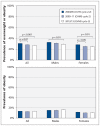Recent trends in the prevalence of overweight and obesity among Canadian children
- PMID: 27160875
- PMCID: PMC5026530
- DOI: 10.1503/cmaj.150854
Recent trends in the prevalence of overweight and obesity among Canadian children
Abstract
Background: Previous studies have shown an increase in the prevalence of overweight and obesity among Canadian children from 23.3% to 34.7% during 1978-2004. We examined the most recent trends by applying current definitions of overweight and obesity based on World Health Organization (WHO) body mass index (BMI) thresholds and recently validated norms for waist circumference and waist:height ratio.
Methods: We examined directly measured height and weight data from the Canadian Community Health Survey (2004-2005) and the Canadian Health Measures Survey (2009-2013). We calculated z scores for BMI, height and weight based on the 2014 WHO growth charts for Canada, including the new extension of weight-for-age beyond 10 years. To calculate z scores for waist circumference and waist:height ratios, we used new charts from the reference population in the US NHANES III (National Health and Nutrition Examination Survey, 1988-1994).
Results: Data were available for 14 014 children aged 3-19 years for the period 2004-2013. We observed a decline in the prevalence of overweight or obesity, from 30.7% (95% confidence interval [CI] 29.7% to 31.6%) to 27.0% (95% CI 25.3% to 28.7%) (p < 0.001) and stabilization in the prevalence of obesity at about 13%. These trends persisted after we adjusted for age, sex and race/ethnicity. Although they declined, the median z scores for BMI, weight and height were positive and higher than those in the WHO reference population. The z scores for waist circumference and waist:height ratio were negative, which indicated that the Canadian children had less central adiposity than American children in historic or contemporary NHANES cohorts.
Interpretation: After a period of dramatic growth, BMI z scores and the prevalence of overweight or obesity among Canadian children decreased from 2004 to 2013, which attests to progress against this important public health challenge.
© 2016 Canadian Medical Association or its licensors.
Figures


References
-
- Shields M, Tremblay MS. Canadian childhood obesity estimates based on WHO, IOTF and CDC cut-points. Int J Pediatr Obes 2010;5:265–73. - PubMed
-
- Roberts KC, Shields M, de Groh M, et al. Overweight and obesity in children and adolescents: results from the 2009 to 2011 Canadian Health Measures Survey. Health Reports 2012;23(3):3–7. - PubMed
-
- Shields M, Connor-Gorber S, Tremblay MS. Methodological issues in anthropometry: self-reported versus measured height and weight. In: Symposium 2008: data collection: challenges, achievements and new directions. Ottawa: Statistics Canada; 2009. Cat no. 11-522-X.
-
- Corby L, Secker D. Growth monitoring of infants and children using the 2006 World Health Organization [WHO] child growth standards and 2007 WHO growth references. Current Issues [PEN; Dietitians of Canada] 2010. [updated March 2012 and Nov 2013]. Available: https://www.dietitians.ca/Downloads/Public/Growth_Charts_backgrounder_en... (accessed 2016 Apr 19].
-
- Rolland-Cachera MF. Childhood obesity: current definitions and recommendations for their use. Int J Pediatr Obes 2011;6:325–31. - PubMed
MeSH terms
LinkOut - more resources
Full Text Sources
Other Literature Sources
Medical
